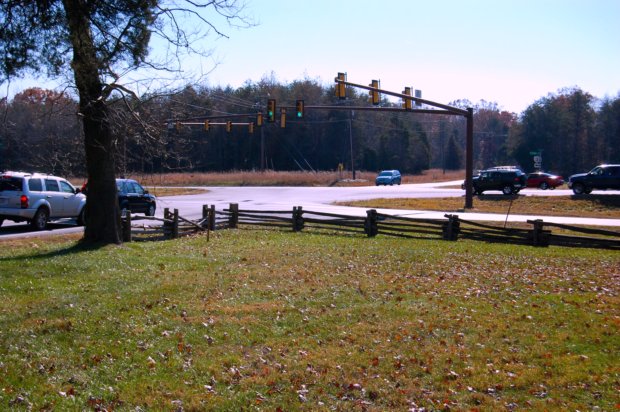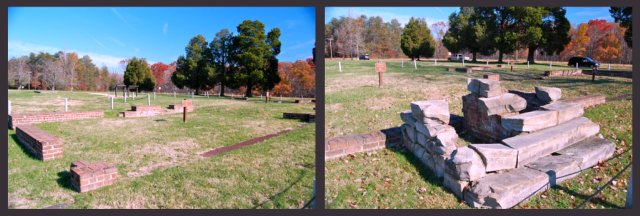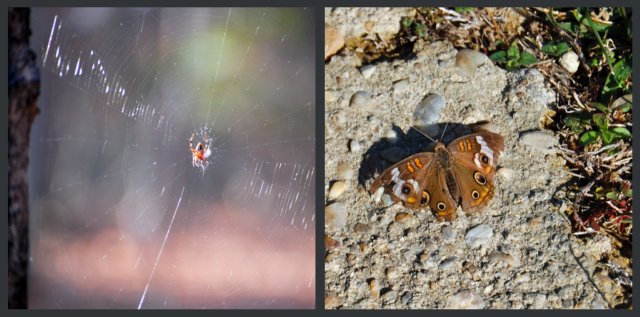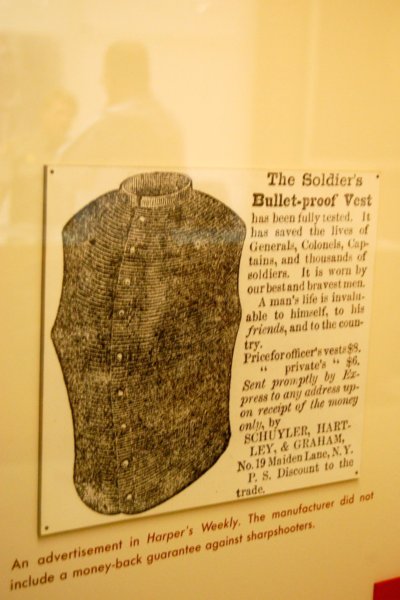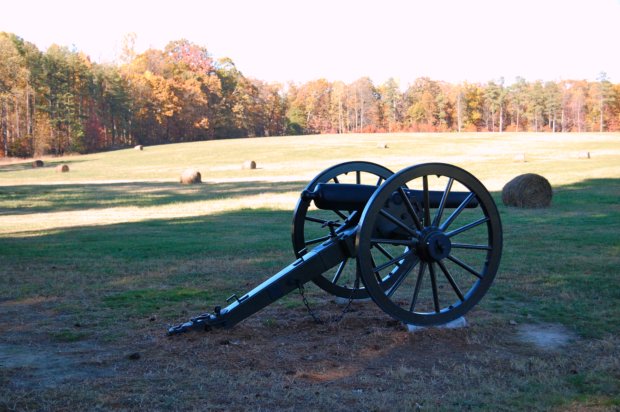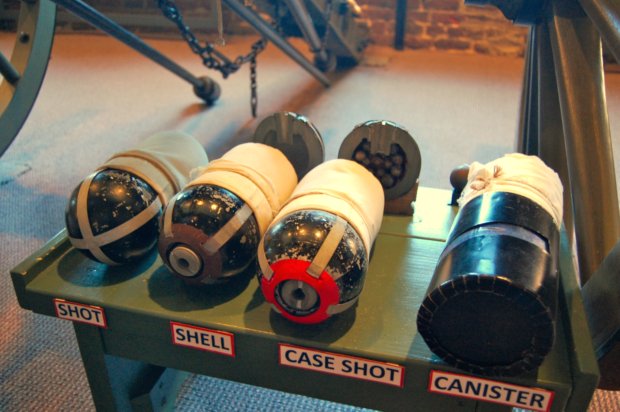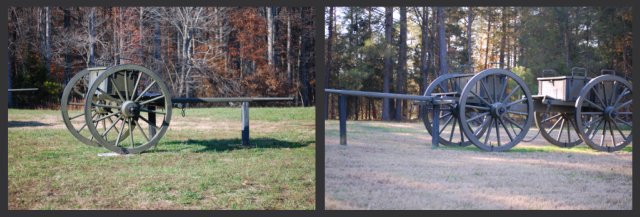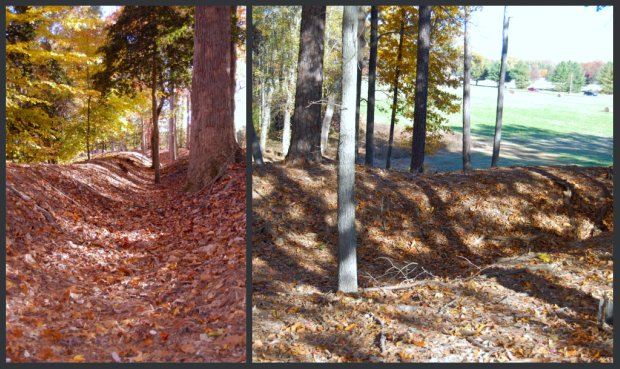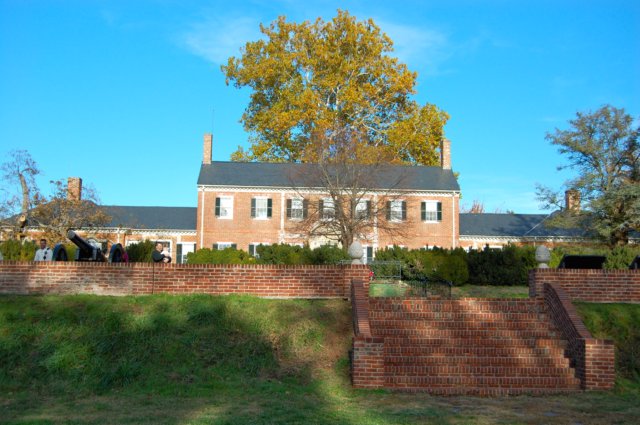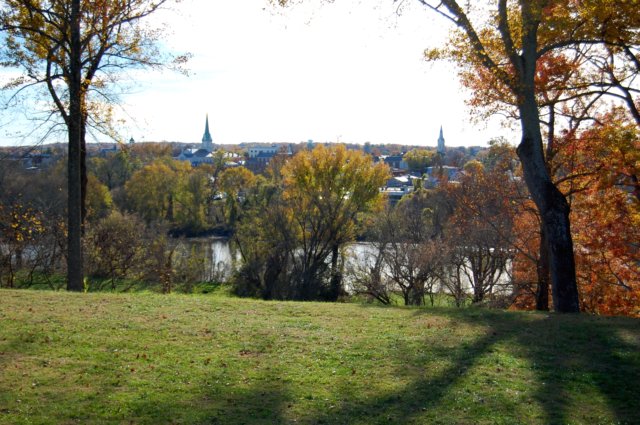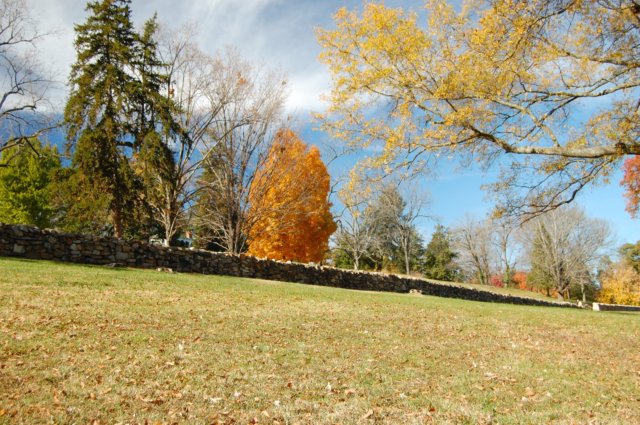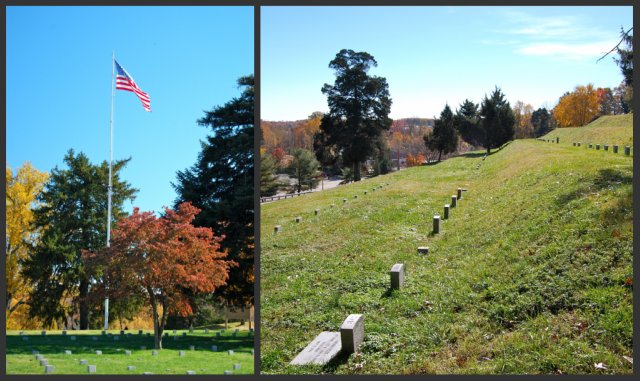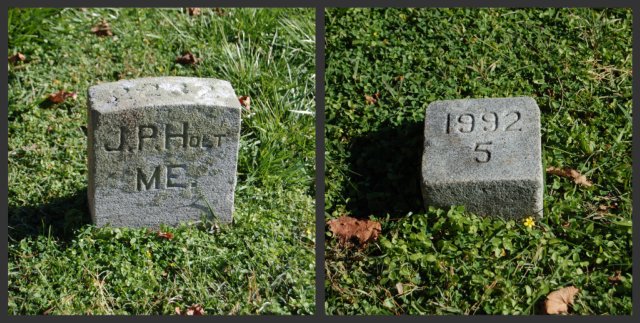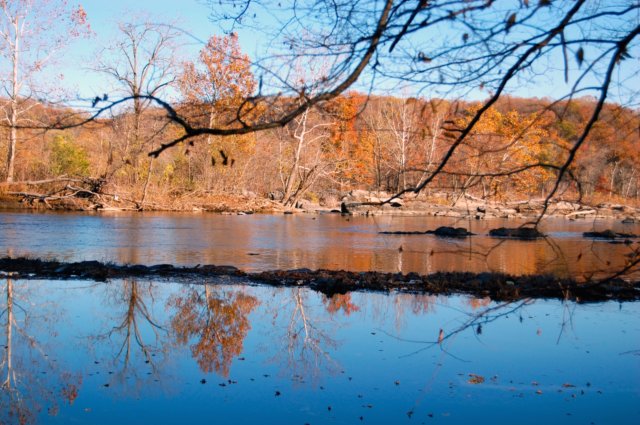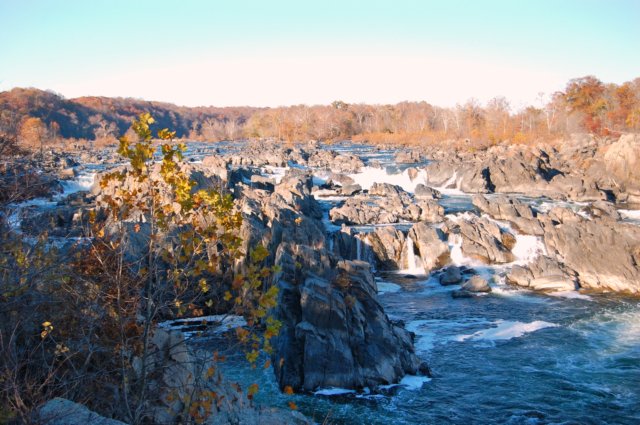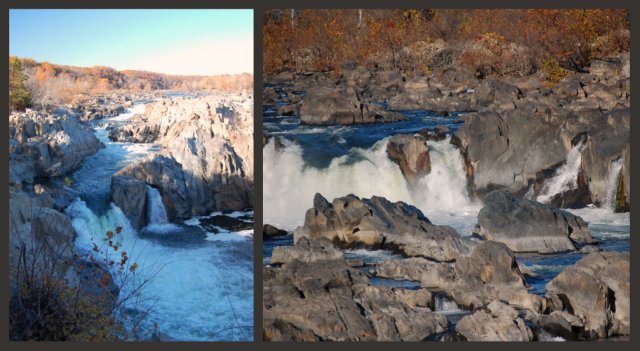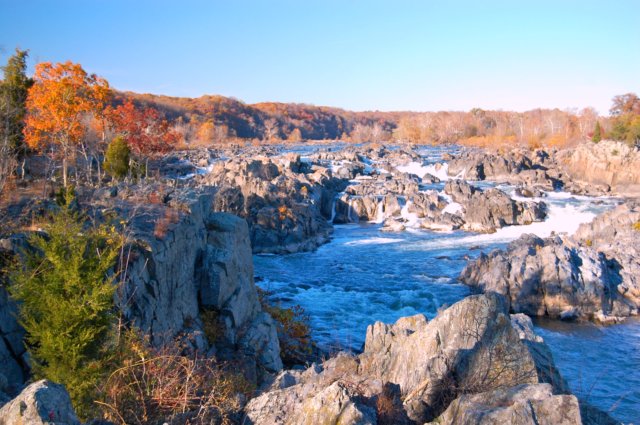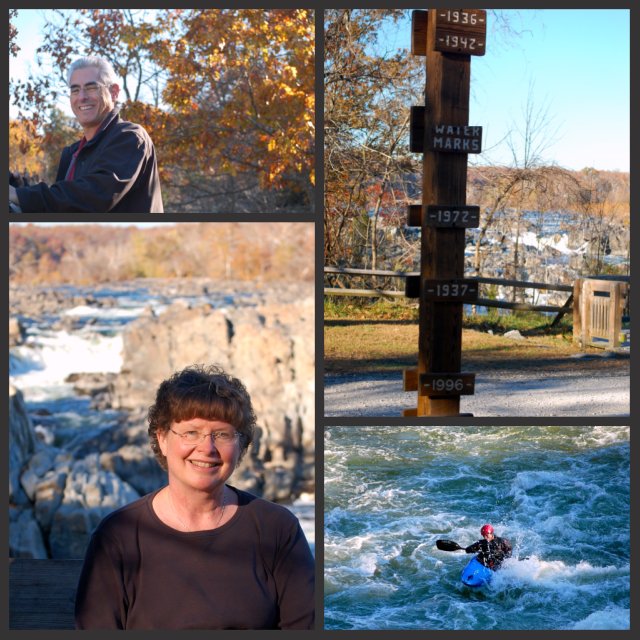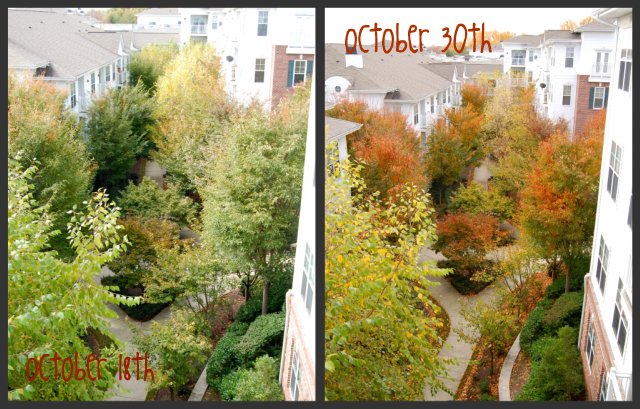The beautiful fall foliage is pretty much gone... and it's beginning to feel like winter, which doesn't officially begin for another month...
Tuesday, November 23
the end of autumn
I think I have mentioned once or twice how much I'm enjoying autumn here on the East Coast. I expected the beautiful fall colors, the crisp days and even a bit of rain. What I didn't expect was how quickly that all changes. In just over a week, the temperatures dropped significantly and the wind really kicked up... and then the leaves on the trees began dropping. In Arizona we have "dust devils"- a strong whirlwind of dust and debris. In Maryland, we have "leaf devils!" And just like "dust devils" in Arizona, they are fascinating to watch. What leaves remain on the trees come off as the "leaf devil" passes through leaving the trees mostly bare.
Monday, November 22
Chancellorsville, Virginia... May 1-3, 1863
Have you ever been in a situation where you lost heart and ran? That is exactly what happened to the Union Army under the direction of General Hooker at the Chancellorsville Battle. By mid-1863, President Lincoln had gone through several generals to command the Army of the Potomac in his search for one who would pursue General Lee and end the war. "Fighting Joe" Hooker seemed like just such a man, boasting "May God have mercy on Bobby Lee, for I shall have none." Events would prove otherwise.
In 1863, Chancellorsville was a convergence of crossroads and a large home owned by the Chancellors, often used as a boarding house. General Hooker made his headquarters at this home as he prepared to engage the Confederate Army. New recruits and supplies had arrived, winter was over and he was eager to get down to business. On the other hand, General Lee had spent the winter trying to ration supplies and boost the dismal morale of his dwindling troops. He received word that the Union Army was fortifying in the Carolinas to move towards Richmond- and Lee could not allow that. He sent some of his troops there, further weakening his troop strength.
In 1863, Chancellorsville was a convergence of crossroads and a large home owned by the Chancellors, often used as a boarding house. General Hooker made his headquarters at this home as he prepared to engage the Confederate Army. New recruits and supplies had arrived, winter was over and he was eager to get down to business. On the other hand, General Lee had spent the winter trying to ration supplies and boost the dismal morale of his dwindling troops. He received word that the Union Army was fortifying in the Carolinas to move towards Richmond- and Lee could not allow that. He sent some of his troops there, further weakening his troop strength.
This intersection of Route 3 and Elys Ford Road is the crossroads at Chancellorsville. Directly behind the camera is the Chancellor House.
On the morning of May 1, 1863 General Hooker had superior strength, supplies and strategic advantage having maneuvered his troops in such a way as to pin General Lee's Army in the hills between two sizable forces. Everyone knew the Confederate Army was in trouble. Hooker sent troops up to the ridge (high ground) where a skirmish with the Confederates ensued. The Union Army pressed on and gained the high ground. Then, for reasons no one quite understands and to the amazement (not to mention disappointment) of his men, Hooker ordered his troops to retreat. Several battles followed until Hooker's army ended up back at the crossroads. Lee ordered heavy artillery fire forcing the final retreat of the Union Army.
The Chancellor House was completely destroyed when fire broke out from the artillery fire. The foundation (left) and front steps (right) are all that remain today.
Did Hooker look at Lee's troops and see a tremendous force even though they were quite teeny-tiny? What made Lee persevere despite being outnumbered and outgunned? I pondered those questions as we drove around the battle/skirmish sites marking Hooker's retreat. I think that I am sometimes like Hooker, seeing problems as mountains instead of the molehills they really are. I don't know if Lee was thinking of Isaiah 40:10- "So do not fear, for I am with you; do not be dismayed, for I am your God. I will strengthen you and help you; I will uphold you with my righteous right hand."- as he persevered and pursued Hooker's mighty army, but I certainly plan to the next time I face a "mountainous molehill."
Today's wildlife! I think the butterfly- larger but retreats when anything approaches- is like General Hooker, while the spider- smaller but stands his ground- is like General Lee.
Wednesday, November 17
God's Crayon Box
The whole concept of autumn- with it's chilly temperatures, frost, brilliantly-colored trees and the aroma of fireplace smoke- is quite intriguing to me, probably because for most of my life it has meant little more than a subtle shift from "scorching hot" to "cool but nice." This year, for the first time in many years, I have watched autumn unfold almost before my eyes. I have worn a jacket in SEPTEMBER! I have watched my frosty breath as I exhale in October. And now, as I walk through our neighborhood in November, I smell the wood burning in the fireplaces and watch the trees change color almost daily.
What makes some trees' leaves turn yellow and/or orange while others turn bright red and purple? Small amounts of yellow and orange pigment are in the leaves all along- we just can't see it during summer when there is so much green chlorophyll, which aids in the process of photosynthesis (turning water and carbon dioxide into oxygen and glucose), in the leaves . During the autumn season, trees begin to go dormant in preparation for winter with its decreased water and sunlight (also necessary for photosynthesis). The green chlorophyll disappears from the leaves leaving behind the yellow and orange pigments. And we see orange and yellow leaves. In some trees, like maples, glucose is trapped in the leaves after photosynthesis stops. Sunlight during the day and cool temperatures at night cause this glucose to turn red- and we see red and sometimes purple leaves. Other trees, like oaks, leave wastes in the leaves- and we see brown leaves.
That is the scientific answer to why leaves turn different colors in the fall. The simple answer is God has a really big box of crayons!
What makes some trees' leaves turn yellow and/or orange while others turn bright red and purple? Small amounts of yellow and orange pigment are in the leaves all along- we just can't see it during summer when there is so much green chlorophyll, which aids in the process of photosynthesis (turning water and carbon dioxide into oxygen and glucose), in the leaves . During the autumn season, trees begin to go dormant in preparation for winter with its decreased water and sunlight (also necessary for photosynthesis). The green chlorophyll disappears from the leaves leaving behind the yellow and orange pigments. And we see orange and yellow leaves. In some trees, like maples, glucose is trapped in the leaves after photosynthesis stops. Sunlight during the day and cool temperatures at night cause this glucose to turn red- and we see red and sometimes purple leaves. Other trees, like oaks, leave wastes in the leaves- and we see brown leaves.
That is the scientific answer to why leaves turn different colors in the fall. The simple answer is God has a really big box of crayons!
"November's sky is chill and drear,
November's leaf is red and sear." Sir Francis Scott
(In case you don't know what "sear" means (I didn't), it's an Old English word meaning "dry"- but, of course, that would not rhyme with "drear!")
Tuesday, November 16
The Battle at Cold Harbor (Virginia)... June 3, 1864
By the summer of 1864, the Union and Confederate Armies had been fighting for three long, bloody years. Materials, men and morale were dwindling. Yet both sides were equally determined to fight to the death; equally convinced there could be no other way to achieve peace. To that end, military strategy and even the "art of combat" changed... often from battle to battle. Walking around the Cold Harbor battlefield, I could imagine the fighting, the carnage, the suffering... and came to respect both those soldiers (Blue and Gray) as well as all our soldiers past and present even more.
The battle at Cold Harbor was fought in central Virginia in and around what is now Mechanicsville (about ten miles northeast of Richmond)- the same ground the armies clashed over in 1862 during the Seven Days Battles. Contrary to its name, there is no harbor at Cold Harbor but rather a meeting of crossroads and a local hotel that provided shelter (harbor) but no hot meals. There were several small skirmishes in late May and early June while the armies were getting into position but the real battle didn't begin until June 3, 1864.
Historians say it is one of America's bloodiest battles- 17,332 men killed, wounded or missing- and an overwhelming victory for the Confederacy. What I found interesting was that despite being out-numbered, out-gunned and without food, the Confederate Army won the battle. Why? Their leader, General Robert E. Lee, knew the big picture (the terrain) and had a plan; the commanders and soldiers were obedient, better disciplined and had better communication to and from General Lee. As I reflected on this while walking through the woods where some of the bloodiest fighting occurred, I was reminded that those same things make the Christian "soldier" victorious in spite of overwhelming odds... believing God, who not only knows the big picture but is sovereign over it, being obedient to His word, self-disciplined in all things and communicating with God through prayer regularly.
It has been said that the American Civil War was both the last of the ancient wars and the first of the modern wars. Certainly this period of history saw many advancements- the use of hot air balloons for reconnaissance, submarines and torpedoes to name a few. Smooth-bore muskets were used by infantry soldiers but snipers (also called sharp-shooters) used rifled muskets to pick off enemy scouts, infantry and especially the soldiers who manned the cannons. The new and improved rifled muskets were reserved for snipers because of their accuracy- from a treetop or lying in a dug out pit, they could hit a target 500 yards away although the distances were usually much less.
The battle at Cold Harbor was fought in central Virginia in and around what is now Mechanicsville (about ten miles northeast of Richmond)- the same ground the armies clashed over in 1862 during the Seven Days Battles. Contrary to its name, there is no harbor at Cold Harbor but rather a meeting of crossroads and a local hotel that provided shelter (harbor) but no hot meals. There were several small skirmishes in late May and early June while the armies were getting into position but the real battle didn't begin until June 3, 1864.
Historians say it is one of America's bloodiest battles- 17,332 men killed, wounded or missing- and an overwhelming victory for the Confederacy. What I found interesting was that despite being out-numbered, out-gunned and without food, the Confederate Army won the battle. Why? Their leader, General Robert E. Lee, knew the big picture (the terrain) and had a plan; the commanders and soldiers were obedient, better disciplined and had better communication to and from General Lee. As I reflected on this while walking through the woods where some of the bloodiest fighting occurred, I was reminded that those same things make the Christian "soldier" victorious in spite of overwhelming odds... believing God, who not only knows the big picture but is sovereign over it, being obedient to His word, self-disciplined in all things and communicating with God through prayer regularly.
It has been said that the American Civil War was both the last of the ancient wars and the first of the modern wars. Certainly this period of history saw many advancements- the use of hot air balloons for reconnaissance, submarines and torpedoes to name a few. Smooth-bore muskets were used by infantry soldiers but snipers (also called sharp-shooters) used rifled muskets to pick off enemy scouts, infantry and especially the soldiers who manned the cannons. The new and improved rifled muskets were reserved for snipers because of their accuracy- from a treetop or lying in a dug out pit, they could hit a target 500 yards away although the distances were usually much less.
Sadly, the photo doesn't show depth but a sniper's pit is right in the middle.
Not many soldiers had "bullet-proof" vests. Interesting that officer's vests were more expensive (33% more!) than those for a private...
One of the very knowledgeable park rangers we met answered my many questions about the cannons- or in Army-speak, the artillery. The Union Army had more cannons throughout the war because they had several cannon foundries compared with one the South had in Richmond. Eight men worked each cannon, drilling and practicing until they could do it in their sleep. Each man on a crew knew every other man's job as they were high-profile targets for the enemy.
This bad boy, knicknamed "Napolean" because French emporer Louis Napolean had supported the development of its design, had a range of about 1600 yards. The crew could prep, load and fire in less than a minute!
Cannons fired several different kinds of projectiles. Perhaps the one used most frequently and inflicting the most damage to people was the canister. The shot was packaged in a" tin can" and when fired, the tin can disintegrated spraying shot everywhere. It was like a really big sawed-off shotgun and was particularly lethal when used at a range of 250 yards or less. Interestingly, artillery fire did not account for the majority of deaths and injury- ordinary musket fire did.
The small ball in back and to the left of the Canister is a piece of shot. The Canister was filled with iron shot about the size of a large cherry.
Cannons were hitched to a two-wheeled carriage called a limber that was hitched to a team of six horses. Each limber carried one box of ammunition; additional ammunition and spare artillery tools were carried on a caisson. Caissons were also hitched to a limber and pulled by a team of six horses. Moving artillery around was neither simple nor quick. And once the cannons were in place, the horses had to be moved farther back, away from enemy snipers. The average age of an artillery horse was just eight months due to hard work, disease and enemy fire.
A limber (left) carried one box of ammunition which the driver sat on. A caisson (right) carried two or three ammo boxes and spare parts.
Trench warfare (a military strategy) was first used by Americans during the Civil War and by the Cold Harbor Battle, it had been nearly perfected, especially by the South. Soldiers dug trenches with whatever they had- shovels, cups, spoons, even their hands. Amazingly, the trenches, although shallower, are still visible nearly 150 years later. Walking beside the long line of trenches, it's not hard to imagine thousands of men lying cramped together waiting for the enemy to approach. At this battle, the Confederates were deeply entrenched and "let" the Union Army come to them. It proved to be a costly mistake for the Union. In his memoirs, General Ulysses S. Grant said, "I have always regretted that the last assault at Cold Harbor was ever made... no advantage whatever was gained to compensate for the heavy loss we sustained."
While the trenches are intact, the landscape, unfortunately, is quite different now. At the time of the battle, trees were much more sparse (for example, not in the middle of a trench!) and there was little or no undergrowth as livestock kept it chewed down.
This was the fourth Civil War battlefield we've visited this year and each one has given me a different glimpse of our country's history in general and the Civil War in particular. The more I learn about this bloody war, the more questions I have!
Sunday, November 14
Fredericksburg, Virginia... December 11-14, 1862
In 1862, Fredericksburg, Virginia was a quaint little town (population about 5,000) situated on the Rappahannock River. Large plantations produced a variety of crops and iron-working and mining were important industries. But it was its proximity to both Washington, D.C. (the Union capital) and Richmond (the Confederate capital) that brought this charming, genteel town into the Civil War... not once, but several times. The first battle took place in mid-December, 1862 when General Burnside's Union Army clashed with General Lee's Confederate Army with disastrous results for the Union.
As we toured the battlefield national park area as well as walked around the old part of town, we began to get a feel for what transpired here almost 150 years ago. It was both sobering and inspiring.
ORDINARY HOMES
General Burnside (Union) wanted to capture Richmond (thus ending the war, in his opinion) which required crossing the Rappahannock River into Fredericksburg. But it would not be an easy endeavor as General Lee (Confederate) had taken the precaution some time ago of burning all the bridges across the wide river. Burnside's plan was to meet the Army engineers across the river from Fredericksburg, have them build a pontoon bridge and then, with the element of surprise on their side, march into town. However, the pontoons arrived ten days late, the element of surprise was lost and the Confederate Army was ready and waiting.
General Burnside made his headquarters at Chatham Manor (the Lacy House) on the east side of the river, which had been used by the Union Army since April, 1862. The plantation owner (and slave owner), James Lacy, was serving in the Confederate Army as a staff officer when Union troops arrived and commandeered the estate. His wife and children abandoned the plantation and moved across the river to Fredericksburg.
As we toured the battlefield national park area as well as walked around the old part of town, we began to get a feel for what transpired here almost 150 years ago. It was both sobering and inspiring.
ORDINARY HOMES
General Burnside (Union) wanted to capture Richmond (thus ending the war, in his opinion) which required crossing the Rappahannock River into Fredericksburg. But it would not be an easy endeavor as General Lee (Confederate) had taken the precaution some time ago of burning all the bridges across the wide river. Burnside's plan was to meet the Army engineers across the river from Fredericksburg, have them build a pontoon bridge and then, with the element of surprise on their side, march into town. However, the pontoons arrived ten days late, the element of surprise was lost and the Confederate Army was ready and waiting.
General Burnside made his headquarters at Chatham Manor (the Lacy House) on the east side of the river, which had been used by the Union Army since April, 1862. The plantation owner (and slave owner), James Lacy, was serving in the Confederate Army as a staff officer when Union troops arrived and commandeered the estate. His wife and children abandoned the plantation and moved across the river to Fredericksburg.
Built in the mid-1700's, this 1280-acre plantation was an ordinary plantation home that had some extraordinary visitors: George Washington, Thomas Jefferson, Walt Whitman, Clara Barton and Abraham Lincoln to name a few. It is the only building that both Washington and Lincoln visited.
Once it was taken over by the Union Army, it became a working military post with a strategy center, housing for officers and even was used as a hospital after the battle. Eventually soldiers ripped the paneling off the walls to use as firewood and then marked the walls with graffiti- interesting that the "art" hasn't changed much in over a century!
The top left photo shows the manor's original back entrance which is now the front entrance. Today the National Park Service is housed in the building. The tree in the bottom right photo was there when the battle was fought; most of the other trees on the estate are "new."
By the end of the war, the plantation and manor had been ravaged. Blood stained floors, walls, furniture and draperies. Windows were broken, walls marred and the grounds trampled. It remained a shattered shell of its previous style and elegance until 1920 when new owners restored it to its former beauty.
The proximity to the river (and town) made Chatham Manor a valuable asset to the Union Army. (Chatham Manor is directly behind the camera.) The church spires in Fredericksburg were there at the time of the battle but saw little or no damage.
Back to the battle: The battle was no longer a surprise and General Lee had reinforced his position in two places- directly across the river in the homes that lined the riverfront and in the surrounding hills. When the pontoons finally arrived, Union engineers began putting the bridges together under cover of fog. As the fog lifted, Confederate snipers across the river began picking them off. The Union responded with cannons (causing much damage to the houses across the river) and drove the Rebel soldiers back. The Union Army finally crossed the Rappahannock only to loot the homes and shops, destroying and stealing whatever they could- not their finest moment.
Meanwhile, General Lee was reinforcing his position across town at Marye's Heights, a natural high ground with a sunken road at the base. And as if the high ground and sunken road were not enough of an advantage, there was also a stone fence the entire length of the field.
The Sunken Road is on the other side of the wall, most of which has been restored or rebuilt since the battle. There is one section of original wall at the far right side.
The Union Army advanced from the riverfront, passing houses and businesses, to engage the Confederate Army here at Marye's Heights.
Union soldiers marched up through the now modern neighborhood in the back, which would have been mostly fields and a few houses, past this house that was there during the battle. How close was it to the "front?"
THAT close!
The modest Innis House had wisely been evacuated by the Confederate Army prior to the onslaught of fighting. The National Park Service has restored the outside of the house leaving just one small section to show damage. But the inside of the house is pockmarked from musket and artillery fire. Although the house is locked at this time, you can peer in the windows for a look back into time.
Left- One of only a few original planks in the Innis House showing musket ball damage.
Right- The left gate post of this private family cemetery shows artillery damage.
After a few small skirmishes, the battle at Marye's Heights began in earnest. Union soldiers started advancing across the open fields but division after division was cut down by Confederate artillery and musket fire with no Union soldier getting within 25 yards of the stone wall. Confederate soldiers watched in disbelief as wave after wave (six in all) of Union troops kept on coming straight at the wall but they continued to fight. Mercifully, night came and the fighting stopped. The Union Army suffered nearly 13,000 casualties that day- and the enemy was still in place. The next evening the Union Army began their retreat.
EXTRAORDINARY MEN
As night fell on December 13, 1862 the field in front of the stone wall was littered with dead, dying and wounded Union soldiers. Those that could walk made their way to the back. Doctors and nurses helped those who were near the back, working towards the front. As dawn broke on December 14th, thousands of wounded soldiers were still lying on the field. As the day wore on, their pleas for water, blankets and help were deafening. Both sides were emotionally moved but also fearful to help. Until Richard Rowland Kirkland, a Confederate sergeant filled as many canteens as he could carry with water, gathered blankets and rushed out onto the battlefield... to help his ENEMY! Union soldiers looked on in disbelief while Confederate soldiers stood ready to mow down anyone who even looked like they might harm the sergeant. Kirkland made numerous trips at great risk to himself to help not only people he did not know, but people who just hours before he had been shooting at.
Kirkland was described by friends as a religious, moderately educated, kind young man. He went on to fight in several more battles before being mortally wounded in the Battle of Chickamauga in 1863. His final words were, "Tell my pa, I died right."
Although most of the townspeople fled the battle scene, they often were not far away witnessing the thick smoke in the air and the hoarse screams of wounded soldiers. After the battle, they returned only to find their homes badly damaged, their possessions plundered and make-shift graves in their yards. With perseverance and hard work they set about rebuilding their homes and town.
The soldiers on both sides were mostly young men who were somewhat educated. They were God-fearing, hard working "regular Joe's." Most were passionate about their beliefs and reasons for fighting. Those who died in battle were either buried at the battle site (Union) or returned to Richmond for burial (Confederate). After the war, the bodies of Union soldiers at Fredericksburg were exhumed and reburied at the Fredericksburg National Cemetery.
Fredericksburg National Cemetery is the final resting place for more than 15, 000 United States soldiers- most of them Union soldiers who died in the battles around Fredericksburg. Sadly, over 80% of the soldiers are unknown.
The graves seem to stretch as far as we could see. The hill is terraced with row after row of graves. Some have markers with a name and state identified. Other, smaller markers, have two numbers- the top number is the site number and the bottom number indicates how many bodies are buried in that grave.
Mass graves do exist... right here in the United States.
Dead Confederate soldiers that were not moved to Richmond were buried at the Confederate Cemetery in Fredericksburg. It is much smaller and more run-down looking. It seemed that they also used mass graves for unknown soldiers- 2184 of the 3300 Confederate soldiers are unknown.
We wondered if President Lincoln had been alive to oversee the reburial process if there would be just one cemetery for all United States Civil War soldiers, rather than separate ones. As he once said, "A house divided against itself cannot stand."
Friday, November 12
Great Falls on the Potomac
When I think of Great Falls I think of Montana. Or Niagara Falls. I was surprised to learn there is another one- and we spent this beautiful autumn afternoon exploring the Great Falls on the Potomac. The Potomac River is a large river that forms borders between parts of Maryland and Virginia as well as parts of Virginia and the District of Columbia. The George Washington Parkway runs along the river where drivers often spot native birds and animals. In fact, we saw egrets, lots of squirrels and a deer!
The river is about 1000 feet wide above the Great Falls- very serene and majestic-looking. The trees along the bank are losing their leaves leaving the floor covered with dry brown leaves. We watched squirrels scamper noisily through them as we walked along the trail for a bit.
The river is about 1000 feet wide above the Great Falls- very serene and majestic-looking. The trees along the bank are losing their leaves leaving the floor covered with dry brown leaves. We watched squirrels scamper noisily through them as we walked along the trail for a bit.
Although the water looks still as a lake, it was moving at a good clip on the other side of the rock formation. The water in the foreground was a backwater area and was fairly still.
There are three viewing platforms, a picnic area and a nicely done Visitor's Center in the park (Great Falls National Park). We spent about a half hour in the Visitor Center before heading to the first viewing platform. As we approached it, the sound of rushing water crescendoed to a deafening roar.
You can see the relatively calm water way upstream and then the turbulent water below the falls.
The river drops 76 feet in elevation over a distance of less than a mile. This creates cascading rapids and several 20-foot waterfalls. They are spectacular!
There are signs posted everywhere warning visitors not to climb on the rocks or go beyond the viewing platforms. The currents and undertow in the river are so strong that if you fall in, you will die. Seven people have died in the river so far this year. It is not hard to imagine the brute power.
From the third platform we could see the whole width of the falls. What we saw today was "below normal" water flow. One display showed pictures from floods, in the spring when water flow is high and in times of low water flow.
Beautiful!!
We watched a kayaker practice in some rapids below the falls. After resting a bit in an eddy, he would paddle upstream into the rapids and then go across the waves before returning to the eddy. We watched him flip his kayak over several times... perhaps to cool off.
The river is about 200 feet away and 100 feet below the High Water Pole. There are pictures of the park website of flood stage... amazing and horrifying at the same time!
We enjoyed the afternoon and plan to come back throughout the year. The falls are only about 14 miles from the Capital and are, I imagine, one the local gems that many people are unaware of. Shhhh... don't tell!
Thursday, November 11
cleaning... house and hearts
Bi-weekly housekeeping service is included in our rental contract for our apartment. Every other Tuesday a team of three women descend on our apartment and in about fifteen minutes they have changed the sheets, cleaned the bathrooms and kitchen, dusted and vacuumed. Yes, I said fifteen minutes. As my grandmother would say, it's more of "a lick and a promise" with a lot of things getting "swept under the rug!" On the off weeks I do a more thorough cleaning. However, traveling and having fun has interrupted my usual cleaning schedule and this week I was left with a mess. As I walked around surveying the pit of despair our apartment had become (and taking pictures for those of you who think my house never gets dirty!), several thoughts came to mind.
What initially began as just a messy kitchen soon spread to the dining room table...
... and before I knew it, the living room was a mess.
And the ugly truth is that is wasn't long before the mess had spread to our bedroom...
... and then the guest room.
The clutter and filth in our apartment is just like sin in my life. It starts out innocently enough... just a few papers left on the kitchen counter... or a little arrogance in my heart. Without any fanfare it silently takes over the counter and spills onto the dining room table... the pride in my heart grows and flows out of my mouth. Without constant de-cluttering and cleaning, the mess grows... and so does the sin. And the fifteen minute "lick and a promise" cleaning just doesn't get it all... like going to church on Sunday but ignoring God the rest of the week keeps me from shining as I reflect God's love.
What is needed is a thorough cleansing getting deep into the nooks and crannies to remove the hidden filth. In the case of my messy apartment, cleaning products and elbow grease took care of it. In the case of my sin, confession and repentance followed by trusting in the Lord's forgiveness were needed. In both cases, the process needs to be repeated often.
"Oh what joy for those whose disobedience is forgiven, whose sin is out out of sight! Yes, what joy for those whose record the Lord has cleared of guilt, whose lives are lived in complete honesty.
When I refused to confess my sin, my body wasted away and I groaned all day long. Day and night your hand of discipline was heavy on me.
My strength evaporated like water in the summer heat.
Finally, I confessed all my sins to you and stopped trying to hide my guilt. I said to myself, "I will confess my rebellion to the Lord."
And you forgave me! All my guilt is gone." Psalm 32:1-5
I love how God uses ordinary, everyday things... like a messy kitchen and cluttered table... to remind me that we are all sinners in need of Christ's love and gracious gift of salvation (Romans 3:23-34).
Tuesday, November 9
it's that time of year again!
Autumn is my favorite time of year. In Arizona, it signals the end (hopefully) of a long, hot summer. In Maryland, it has been a brilliant explosion of colors as the leaves on the trees changed and temperatures dropped. It ushers in Thanksgiving... turkey, stuffing, pumpkin pie, family & friends, grateful hearts. Then the Christmas season begins with all its sights and sounds. All of these things are "expected."
Last weekend when we went to the grocery store, we encountered a totally unexpected part of autumn. Yep, a Girl Scout COOKIE BOOTH!! We discovered that East Coast Girl Scouts have their cookie booths in November rather than springtime as is the case in Arizona. And some of their cookies are different from Arizona! However, the Brownies are just as cute coast to coast.
Last weekend when we went to the grocery store, we encountered a totally unexpected part of autumn. Yep, a Girl Scout COOKIE BOOTH!! We discovered that East Coast Girl Scouts have their cookie booths in November rather than springtime as is the case in Arizona. And some of their cookies are different from Arizona! However, the Brownies are just as cute coast to coast.
Okay, at $4 per box they are not a bargain... but they are yummy!
Wednesday, November 3
autumn's light
Being an Arizona native where the two seasons are hot summer and mild winter, experiencing autumn on the east coast has been a sweet treat. We have often taken weekend trips up to northern Arizona to spy some gold and orange trees but that has been pretty hit or miss. I've always wondered what it would be like to watch the trees change color over several weeks. This year I got my chance- and I learned that the change takes place gradually before exploding in a spectacular way!
"October's poplars are flaming torches lighting the way to winter." ~ Nova Bair
Subscribe to:
Posts (Atom)


